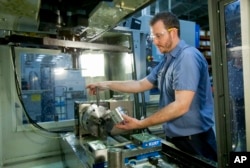Julius Wakam worked in auto manufacturing for 11 years before being laid off in 2008. Today, the married father of three has a job at a hardware store to make ends meet until he can secure another well-paying position in his field.
Like many workers in America's so-called Rust Belt, Wakam lost his manufacturing job not only to an influx of robots, but also because the jobs were shipped overseas where labor is cheaper.
"For me and my co-workers, they shipped the jobs overseas to Mexico, Brazil, China and a few went to India," Wakam says.
Today, the Rust Belt is perhaps best-known for its declining industry, aging and shuttered factories, and falling population, primarily in the Midwest and Great Lakes region.
But the Midwest region was once known for the booming steel production and heavy industry that powered the nation for several generations. And it could be in a position to do so again.
"Probably the greatest driver of our opportunity in a changed economy from the factory era is this innovation infrastructure where we have 20-plus of the largest research universities on earth," says John Austin, director of the Michigan Economic Center. "That’s more than any other region. The West Coast has 13. The East Coast has 15. No place in Europe has this concentration of large scale universities that produce thousands upon thousands of STEM, MBAs, engineers and medical talent.”
The Midwest is also home to more than 200 of the nation’s Fortune 500 companies. Austin says America's Heartland has the horsepower to grow new jobs and industries.
“The Rust Belt can be and is becoming a center of innovation, new business and job creation in all of the arenas that are emerging," he says. "The emerging sectors, the work of tomorrow, not just the work of the past where we kind of ruled the world and created the great agro-industrial economy that powered America after World War II for several generations.”
Austin says some Rust Belt cities have already turned the corner from being single industry towns to more diverse, economic regions. He cites places like Pittsburgh, Indianapolis, Columbus, Ohio, and Minneapolis-St. Paul as examples of metropolitan areas that have built robust economies partially powered by technology and medical innovation.
However, money is key to that transformation and it's been slow in coming. Rust Belt innovations tend to be commercialized on the East or West Coast. And that's where most of the Midwest's investment dollars end up as well.
Half of all investment money comes from the Midwest, but only 5 percent of total venture capital is invested in the Midwest, according to Austin, who says that dynamic must change for the Rust Belt to reach its full potential.
"We are working to create a Midwest/Great Lakes regional fund that would help more of the wealth and investment dollars from the region, and the big dollars on the coast, find good investments and create more jobs and businesses locally," Austin says.
There is a place for laid-off workers like Julius Wakam in the Midwest's emerging new economy. In many cases workers go back to school to learn how to program the robots that supplanted them in the factories where they once worked.
"Someone has to program the robots, someone has to maintain and repair the robots," says James Sawyer, president of Macomb Community College. "So that’s kind of the transformation that’s gone on. The loading jobs no longer exist, but someone, a skilled worker, needs to take care of the robots that replaced that human element."
The Michigan-based community college offers workforce training programs that can last 12-to-18 weeks.
“The majority of our workforce programs tend to focus in the advance manufacturing arena," says Sawyer. "So these are things like robotics, control systems, integration of automation, those types of programs have been very popular in the recent past. And that’s very indicative of the transformation currently going on in manufacturing. So we’re supplying the workers to help do that transformation.”
At the time he was laid off, Julius Wakam was already pursuing an engineering degree at the University of Michigan Dearborn. He completed his degree and then signed up for a workforce training program at Macomb Community College to make himself more marketable.
“That is a program that America really, really needs with the robots taking over," says Wakam.
Although the job search continues, Wakam says he's gotten more interest from potential employers since completing Macomb's workforce training program. He plans to keep looking until he lands a job that utilizes his training and skills.
“To get back to where I was before, the kind of money I was making, that’s what I’m talking about,” he says. "It’s been very rough, but I’m a child of hope. I’m never, never, never going to give up hope and I’m going to keep fighting until I get there.”









